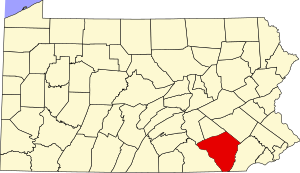Lancaster County | |
|---|---|
 | |
 Location within the U.S. state of Pennsylvania | |
 Pennsylvania's location within the U.S. | |
| Coordinates: 40°02′N 76°15′W / 40.04°N 76.25°W | |
| Country | |
| State | |
| Founded | May 10, 1729 |
| Named for | Lancaster, Lancashire |
| Seat | Lancaster |
| Largest city | Lancaster |
| Area | |
| • Total | 984 sq mi (2,550 km2) |
| • Land | 944 sq mi (2,440 km2) |
| • Water | 40 sq mi (100 km2) 4.1% |
| Population (2020) | |
| • Total | 552,984 |
| • Estimate (2022)[1] | 556,629 |
| • Density | 560/sq mi (220/km2) |
| Time zone | UTC−5 (Eastern) |
| • Summer (DST) | UTC−4 (EDT) |
| Congressional district | 11th |
| Website | www |
Lancaster County (/ˈlæŋkɪstər/; Pennsylvania Dutch: Lengeschder Kaundi), sometimes nicknamed the Garden Spot of America or Pennsylvania Dutch Country, is a county in the Commonwealth of Pennsylvania, United States. As of the 2020 census, the population was 552,984, making it Pennsylvania's sixth-most populous county.[2] Its county seat is also Lancaster.[3] Lancaster County comprises the Lancaster metropolitan statistical area. The county is part of the South Central region of the state.[a]
Lancaster County is a tourist destination with its Amish community being a major attraction. The ancestors of the Amish began to immigrate to colonial Pennsylvania in the early 18th century to take advantage of the religious freedom offered by William Penn,[4] as well as the area's rich soil and mild climate.[5] They were joined by French Huguenots fleeing the religious persecution of Louis XIV.[6][7] There were also significant numbers of English, Welsh and Ulster Scots (also known as the Scotch-Irish in the colonies).
- ^ "QuickFacts: Lancaster County, Pennsylvania". Census.gov. Retrieved July 7, 2023.
- ^ Cite error: The named reference
new-censuswas invoked but never defined (see the help page). - ^ "Find a County". National Association of Counties. Archived from the original on May 31, 2011. Retrieved June 7, 2011.
- ^ Introduction Archived December 8, 2013, at the Wayback Machine. Xroads.virginia.edu. Retrieved December 23, 2010.
- ^ lancaster, pa. Web.archive.org (March 11, 2007; retrieved December 23, 2010.)
- ^ THE PENNSYLVANIA LEFEVRES. History and Genealogy Book accessed May 31, 2009
- ^ "Historical papers and addresses of the Lancaster County Historical Society" County Historical Society pages 101–124. pub 1917
Cite error: There are <ref group=lower-alpha> tags or {{efn}} templates on this page, but the references will not show without a {{reflist|group=lower-alpha}} template or {{notelist}} template (see the help page).

